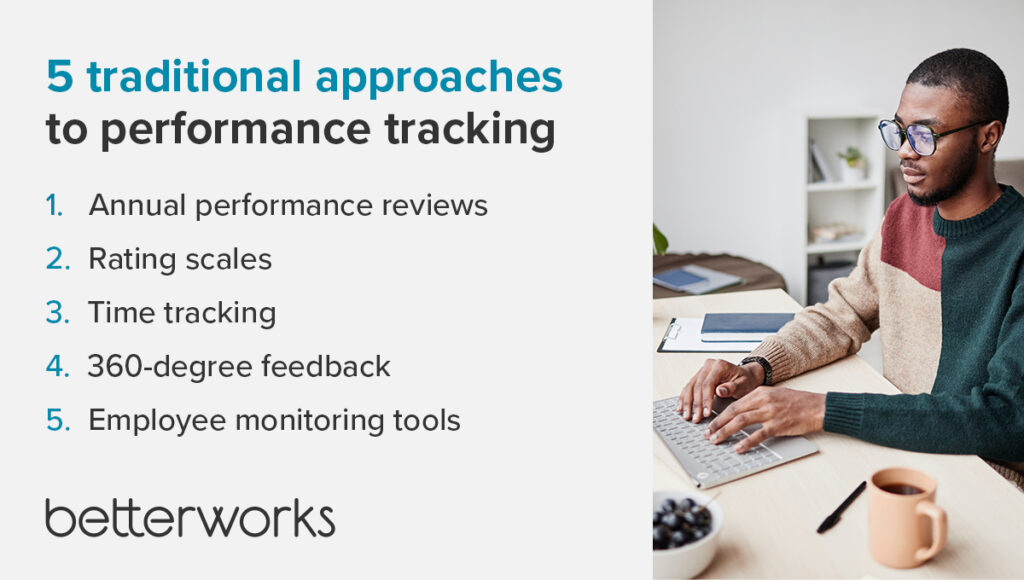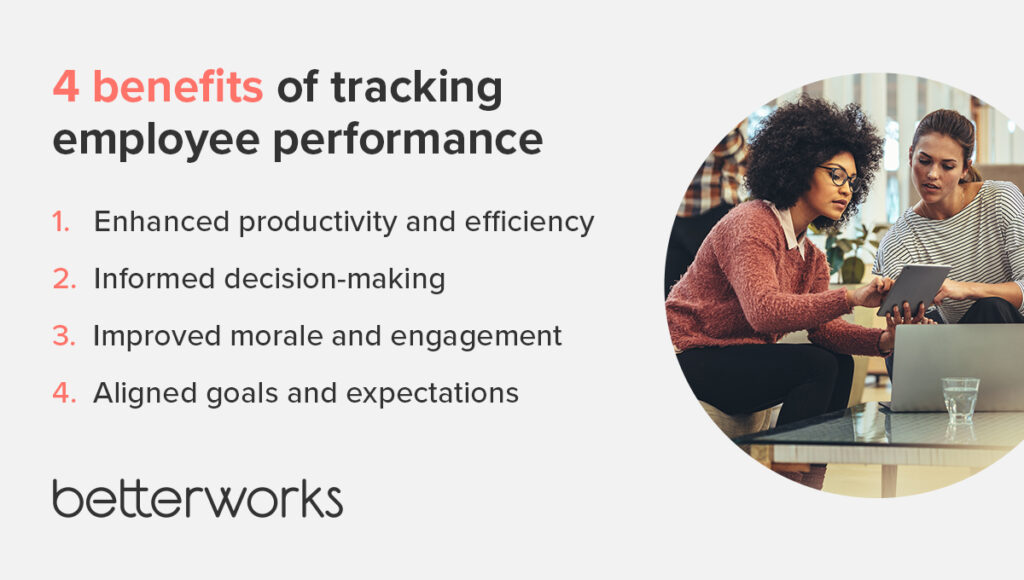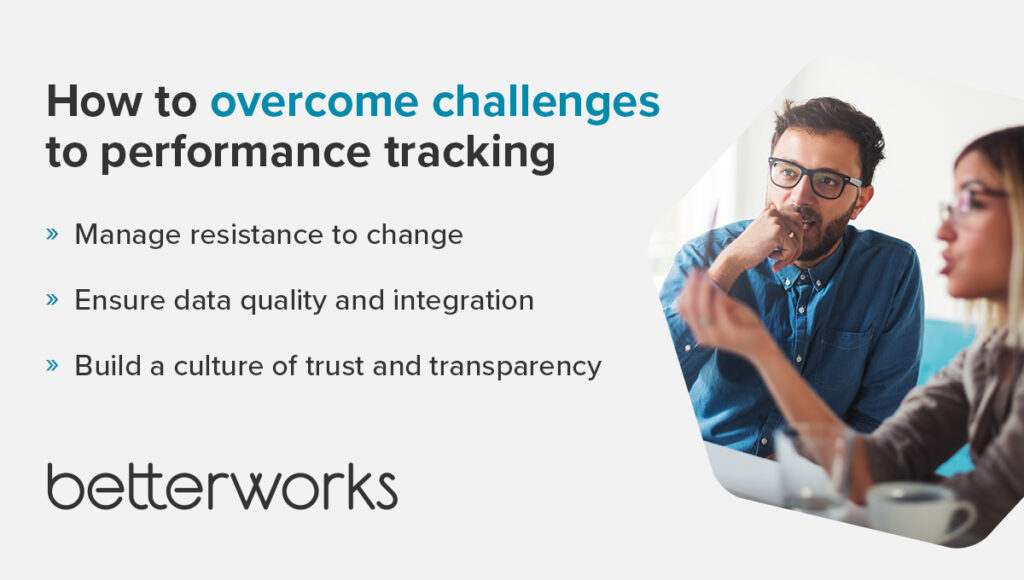Unlocking the full potential of your workforce begins with effective employee performance tracking, a game-changing strategy that transforms productivity and engagement. But traditional metrics and methods are no longer enough to capture the full spectrum of an employee’s contributions or foster their growth.
Employees are 31% more likely to feel highly productive when they view performance management processes as successful, according to our 2024 State of Performance Enablement report. However, employees are 57% less likely than leaders to think that performance management processes are a success, highlighting a significant perception gap between different levels within organizations.
Learn about the limitations of traditional approaches to performance tracking and why we need a more holistic, developmental perspective that aligns with contemporary business needs.
5 traditional approaches to performance tracking and their limitations
Traditional performance tracking methods, from annual reviews to 360-degree feedback, might have been more effective in static work environments. But in today’s fast-paced, integrated workplaces, they have significant limitations. Here are some common approaches to tracking performance — and where they often fall short.
Annual performance reviews
Annual performance reviews often struggle to effectively track and improve employee performance because they occur only once a year. This infrequency leads to outdated feedback that doesn’t reflect an employee’s day-to-day activities or immediate challenges, making it hard for them to adjust and grow consistently throughout the year. Annual performance reviews are also a look back rather than being focused on promoting continuous improvement.
Rating scales
Traditional rating scales on performance evaluations can fall short because they oversimplify an employee’s work and achievements. By trying to fit complex tasks and skills into simple numbers or categories, important aspects like creativity and teamwork might get overlooked. Plus, these scales can be subjective, leading to unfair judgments — and inaccurate data — if managers apply them inconsistently.
Time tracking
Time tracking is a common traditional performance metric, but it focuses too much on how long employees work rather than the quality or impact of their work. This approach misses the mark by not recognizing efficiency, creativity, or fast results. It’s also out of step with today’s flexible and remote work trends, where what you accomplish matters more than the work hours you keep. Employees might feel they’re only appreciated for their hours, not their actual contributions, discouraging those who are efficient and innovative.
360-degree feedback
Traditional 360-degree feedback can be more problematic than helpful in tracking performance. Its complexity and the time it takes to analyze feedback from many sources can slow down the process of giving useful advice to employees. The feedback might also be mixed or biased, reflecting personal views more than objective performance, which can leave employees confused about what to improve.
Employee monitoring tools
Monitoring employee performance is vastly different from micromanaging employees’ actions. Employee monitoring tools that track every action can be counterproductive for performance tracking. They put too much emphasis on how busy employees appear, rather than on the actual quality or results of their work.
Employee monitoring software fosters a workplace culture that values appearances over genuine productivity and innovation, ultimately hindering the performance these tools are supposed to improve. It also fosters distrust, can increase stress and burnout, lower employee morale, and impede employees’ ability to think creatively and strategically.

4 benefits of tracking employee performance
Effective performance tracking enhances individual employee contributions and strengthens the organization’s overall effectiveness and cohesion. Here are four key benefits of implementing a comprehensive employee performance tracking system in your organization.
Enhanced productivity and efficiency
Effective employee performance tracking identifies strengths and areas for improvement, allowing managers to tailor development programs that elevate productivity and operational efficiency. For instance, a software development company might use performance tracking to pinpoint areas where developers excel or struggle, and then offer targeted training sessions or pair developers with mentors to improve their skills.
This targeted approach ensures that employees are not only more proficient in their roles but also more efficient, contributing to quicker project turnarounds and higher-quality outputs.
Informed decision-making
With accurate performance data at their disposal, leaders can make more informed decisions regarding promotions, compensation, and succession planning — guaranteeing that they recognize and nurture the right talent.
Consider a scenario in a sales department where data from performance tracking shows a consistent top performer. Armed with this data, management can confidently decide to promote this individual to a senior sales role, knowing that their decision is backed by empirical evidence of the employee’s achievements and potential for future success.
Improved morale and engagement
Transparent and developmental performance tracking fosters a culture of continuous improvement and recognition, significantly improving the employee experience as well as morale and engagement.
Consider a retail company, for example, that’s implemented a system where employee achievements are regularly acknowledged through a digital platform accessible to all staff. This transparency not only motivates individuals by recognizing their hard work but also encourages others to strive for similar recognition, thereby enhancing overall morale and engagement across the company.
Aligned goals and expectations
Performance tracking helps in aligning individual objectives with organizational goals, ensuring every team member is moving in the same direction toward collective success.
For example, a healthcare provider could implement performance tracking that aligns nurses and administrative staff with the broader objective of improving patient care. By clearly communicating how each role impacts patient outcomes and tracking progress toward these goals, employees can see the direct results of their efforts, fostering a more coordinated and motivated workforce.

Shifting from performance tracking to performance enhancement
The next evolution of performance tracking is performance enhancement. With performance enhancement, you’re not only assessing performance but proactively contributing to each employee’s professional development and well-being. By focusing on growth, learning, and support, companies can unlock the full potential of their teams, drive innovation, and improve competitiveness.
Shifting to a developmental mindset
Embracing a developmental approach to performance tracking requires a shift in mindset for both organizations and managers. This new perspective views each employee not just as a function or a set of results but as a dynamic individual with unique talents, aspirations, and areas for growth. Organizations adopting this mindset acknowledge that the true value of performance tracking lies not in the ratings or rankings it produces but in the conversations and development opportunities it generates.
For managers, this shift transforms their role from traditional “managers” to “enablers” of growth. It challenges the notion that they don’t have the time for ongoing, lightweight conversations with their direct reports. Instead, it posits these interactions as essential, recognizing that the role of a manager in the modern workplace is increasingly about fostering development, offering support, and removing obstacles for their team members. This approach not only enhances individual performance but also builds a stronger, more cohesive team dynamic.
According to Betterworks’ 2023 State of Performance Enablement report, employees who are always satisfied with career and development check-ins are up to 7.5 times more likely to see a path for advancement. They are also more likely to say they are always engaged (75%) and productive (82%), ranking about 20 percentage points higher compared to employees who are sometimes satisfied.
Embracing continuous feedback
Central to the concept of developmental performance tracking is the importance of continuous feedback. Traditional performance reviews often occur annually, providing a retrospective look at an employee’s performance. This model is rapidly being replaced by a more dynamic, ongoing feedback system that supports real-time learning and adjustment. Continuous feedback makes performance management a regular part of the workday, not an isolated event, allowing employees to quickly apply insights and corrections to their work.
This model benefits not just the employee but the entire organization. For employees, regular feedback demystifies performance expectations and provides clear, actionable insights for improvement and growth. For managers, it cultivates a culture of open communication and trust, enabling them to guide their teams more effectively toward organizational objectives. And for business leaders, it generates a stream of data for better performance analytics.
Moreover, continuous feedback mechanisms encourage a two-way dialogue, where employees can also share their insights and feedback with managers, fostering a sense of belonging and mutual respect. This reciprocal nature of feedback ensures that performance enhancement is not a top-down directive but a shared journey toward excellence and innovation.
How to overcome challenges to performance tracking
Transitioning to a more nuanced and holistic model of performance tracking is not without its hurdles. However, by prioritizing clear communication, leveraging advanced technology, and fostering a culture of trust and transparency, organizations can navigate these challenges successfully.
Manage resistance to change
Change can be daunting, and shifting to a new method of performance tracking can meet with resistance from both managers and employees who are accustomed to the old ways. Overcoming this resistance requires clear communication about the benefits of the new system and involving stakeholders in the transition process. Training sessions and pilot programs can also help ease the transition, showing the tangible benefits of the new approach in real time.
Ensure data quality and integration
For performance tracking to be effective, the data must be accurate, relevant, and comprehensive. Organizations need robust systems to collect and analyze quantitative and qualitative performance data, ensuring it provides a true representation of employee achievements and areas for improvement.
Additionally, integrating this new data with existing HR systems can be a technical challenge. Using advanced data management tools and seeking expertise in system integration are crucial steps to maintaining data integrity and utility. Betterworks integrates with a wide variety of workplace tools, like Slack, to capture the full scope of employee performance — not just the tasks they’ve checked off in your project management tool or how many hours they’ve worked.
Build a culture of trust and transparency
A successful shift in performance-tracking methods also depends on the organization’s culture. Establishing a culture of trust and transparency is essential to encouraging honest feedback and open communication. This culture shift should emphasize that the goal of tracking performance is to support and develop, not to penalize.
Regularly sharing how performance data is used and how it benefits individual employees and the organization can reinforce trust and buy-in from all team members. The right performance management software, like Betterworks, encourages employees through regular feedback and goal-setting and enables organizations to achieve higher performance through better alignment and efficiency.

Drive engagement and growth with performance tracking
Performance tracking can be a powerful tool for driving employee engagement and organizational growth. By reimagining traditional practices and embracing a more holistic, developmental approach, HR leaders, team managers, and organizations can foster a more motivated, satisfied, and high-performing workforce. In doing so, they not only enhance individual careers but also propel their organizations forward in a competitive and ever-changing business environment.
Want to learn more? Check out these best practices for performance review process improvement.
There’s a better way to do performance reviews





